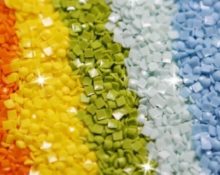Spectacular paintings laid out with diamond mosaics always delight and give pleasure when contemplating them. I would like to try this needlework technique myself for patient and purposeful people. Those who have already known the joy of this type of creativity are sometimes faced with not very pleasant “surprises” in the form of a lack of consumables or drying out of the adhesive surface. Read on to learn how to properly glue rhinestones in diamond embroidery and what to do in case of poor-quality fastening.
The nuances of attaching diamond rhinestones
Important! When starting to work on embroidery, place the canvas on a flat horizontal surface. It should be covered with a thin glossy film or tracing paper, which is not recommended to be removed immediately during work.
 The protective layer is applied in strips to the circuit or as a single sheet. Select the required fragment of no more than 5–6 sq. cm. and only this section of paper is folded or cut out. Usually the layout begins from the upper left corner, so as not to accidentally disturb the already glued pattern with a hand movement.. It is advisable to lay it out immediately, without delaying it for later, as this can lead to the sticky layer drying out and becoming dirty. If you need to leave, be sure to cover the unfinished area.
The protective layer is applied in strips to the circuit or as a single sheet. Select the required fragment of no more than 5–6 sq. cm. and only this section of paper is folded or cut out. Usually the layout begins from the upper left corner, so as not to accidentally disturb the already glued pattern with a hand movement.. It is advisable to lay it out immediately, without delaying it for later, as this can lead to the sticky layer drying out and becoming dirty. If you need to leave, be sure to cover the unfinished area.
To avoid unevenness and row displacement straighten the finished part immediately using a ruler before the glue sets, applying it along horizontal and vertical lines. This will give neatness and clarity to the pasted areas.
How to glue rhinestones in diamond embroidery?
 Ready-made sets with diamond embroidery are sometimes equipped with a stylus or tweezers for laying out stones. The stylus is a special plastic stick with a tip, which is dipped into silicone gel and transfers the rhinestones stuck to it onto the design. The handle is in a perpendicular position. The gel itself remains liquid and can be easily removed from the instrument at the end of work. You can remove an erroneously placed bead by slightly prying it with a utility knife.
Ready-made sets with diamond embroidery are sometimes equipped with a stylus or tweezers for laying out stones. The stylus is a special plastic stick with a tip, which is dipped into silicone gel and transfers the rhinestones stuck to it onto the design. The handle is in a perpendicular position. The gel itself remains liquid and can be easily removed from the instrument at the end of work. You can remove an erroneously placed bead by slightly prying it with a utility knife.
Faceted diamonds are more convenient to pick up with tweezers. To style smooth and round ones, it is better to use a stylus.
What can replace glue?
Many needlewomen, ordering kits in China, complain about low-quality goods: lack of rhinestones, crumpled fabric, complex keys, mismatch of patterns and colors. There is also a problem in the poor-quality adhesive layer, which is the reason for the lack of fixation in some places of the beads. Therefore, we recommend buying products from trusted manufacturers.
What to do in such cases? Here are some tips, collected from craft forums, on how to attach a mosaic to a canvas:
 if there is no glue in the purchased kit, and several rhinestones have fallen off or have not stuck at all, try glue for joining puzzles, which can be purchased at office supply stores;
if there is no glue in the purchased kit, and several rhinestones have fallen off or have not stuck at all, try glue for joining puzzles, which can be purchased at office supply stores;
there is a chance to activate the sticky layer by running a brush moistened with nail polish remover over it;- Construction retail outlets sell Moment Crystal universal adhesive, which has a transparent texture. Suitable for fabrics, leaves no marks. Drying time allows you to change or remove erroneously fixed rhinestones;
- when you need to fill in a small dried fragment of a painting, try using colorless thin double tape;
- PVA glue, just first test it somewhere along the edge so as not to spoil the entire canvas;
- Online stores for creativity sell inexpensive kits for laying out mosaics, which include everything you need, including glue for resuscitating the layer.
What to do if the glue has dried?
It depends on its chemical composition. For example:
- You can try to dilute PVA stationery glue with hot water;
- superglue can be dissolved with acetone;
- Epoxy glue mixes well with alcohol and acetone.
Other types of glue in tubes cannot be restored.
The technique of making mosaic paintings allows you to calm the nervous system and relax. Helps to relax during fatigue and stress. Working together with children is quite an exciting activity that develops finger motor skills, thinking and aesthetic taste of the child.


 if there is no glue in the purchased kit, and several rhinestones have fallen off or have not stuck at all, try glue for joining puzzles, which can be purchased at office supply stores;
if there is no glue in the purchased kit, and several rhinestones have fallen off or have not stuck at all, try glue for joining puzzles, which can be purchased at office supply stores; 3
3





